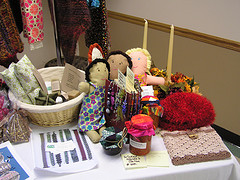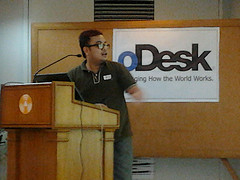Archive for the ‘E-mail & the internet’ Category
Friday, February 14th, 2014

Photo credit; Tanenhaus on Flickr
Rachael Zelensky makes it her mission to help Australian craftspeople sell what they make.
Zelensky is the Managing Director of Boutique Markets, which operates quarterly markets selling hand made goods around Australia.
“It’s small business providing a new twist on retail,” say Zelensky. “Customers want to get away from the normal retail format and are looking for something personal and unique.”
Zelensky says market stores are incredibly popular with women – with mothers making up 75% of owners.
“The markets are a platform for interaction,” said Zelensky. “They start as small businesses but get bigger.”
Locally, the demand for something special that is not mass produced is also huge.
“We recently had our Melbourne Christmas market at the Caulfield racecourse,” said Zelensky. “Three ATMs were on site and two were cleared of cash.”
Although Boutique Markets doesn’t sell online, their website is a place for craftspeople to connect and find out when the next big show is.
To read more about this story, click here.
Tags: Australia, Boutique Markets, business, online
Posted in Australia, business, E-mail & the internet | No Comments »
Wednesday, February 12th, 2014

Photo credit; SEOPlanter on Flickr
More Australians continue to to turn toward online shopping, according to a study done by the ARC Centre of Excellence for Creative Industries and Innovations and Swinburne University of Technology as part of the World Internet Project (WIP).
The study looked at online purchasing habits between 2007 and 2013 and found that three out of 10 Aussies shop online at least once per week now.
“After an apparent plateau between 2009 and 2011, our latest survey confirms that online shopping by Australian consumers grew strongly again between 2011 and 2013,” said Dr Scott Ewing of the centre and Swinburne University of Technology.
The average number of online purchases by Australians grew 46.2 per cent from 2011 to 2013, and the monthly value of average purchases grew 5.8 per cent, to $218.
Men spend more online, averaging $229 a month, while women on average spend $204.
“The good news for Australian businesses is that local retailers are maintaining their share of this growth as Australian consumers maintain their strong preference for shopping with domestically based websites,” Dr Ewing said.
“Three out of 10 Australians now shop online every week, or more often, compared with two in 10 New Zealanders and one in 10 Swiss.
To read more on this story, click here.
Tags: Australia, business, customers, online, shopping
Posted in Australia, business, E-mail & the internet, internet usage, online business, Online Sales, online shopping, online stores, selling online | No Comments »
Saturday, February 8th, 2014

Photo credit; Normanack on Flickr
While big businesses in Australia continue to be prone to failure, their smaller counterparts are doing well, starting out small and gaining a dedicated following of customers the old-fashioned way.
These small mum and pop shops sell anything from handcrafted goods to greeting cards to furniture, utilizing their online presence to sell their wares both locally and around the world.
“These businesses create niche products that may only tailor to the one per cent. But when you look at the world as your customer base, that one per cent is big business,” says Jason Chuck from Etsy Australia, which supports businesses in selling their handmade goods.
Figures from Etsy Australia show that 90% of sellers are women.
The online marketplace launched in Australia in 2005 and now has tens of thousands of sellers, with 60 per cent of orders going to international buyers.
Markets and online stores are allowing artistic Australians to start small and find their niche customer base before expanding.
To read more about this story, click here.
Tags: Australia, business, Etsy, online, small business
Posted in Australia, business, E-mail & the internet, online business, Online Sales, online shopping, online stores, selling online, Success story | No Comments »
Friday, January 3rd, 2014

Photo credit; Snap on Flickr
Freelancer.com founder Matt Barrie has been named a business winner on Yahoo! Finance Australia’s list of business winners and losers for 2013.
Barrie enjoyed one of the year’s most successful IPOs when shares in the online freelancing network shot as high as $2.60 on their first day.
Coming off a 50 cent issue price, the Freelancer frenzy briefly made the company a billion-dollar concern.
Barrie holds 46% of the company and, even with Freelancer shares now trading around $1.30, his stake is still worth approximately $260 million.
To read more on this story, click here.
Tags: Australia, business, Freelancer.com, IPO, Matt Barrie, online, Yahoo!
Posted in Australia, business, E-mail & the internet, internet usage, investment, online business, Success story, technology, web-based | No Comments »
Wednesday, January 1st, 2014

Photo credit; Alisa on Flickr
Online freelance agency oDesk.com, which recently merged with rival Elance.com, is considering opening an office in Australia to compete with Australia-based Freelancer.com.
Matt Cooper, oDesk’s vice-president of its international division, said Australia was now the company’s second-largest market globally with more than 50,000 registered clients. He also mentioned that oDesk, which is based in Silicon Valley, has twice the penetration rate in Australia as compared with its home market of the US.
To read more on this story, click here.
Tags: Australia, business, Freelancer.com, oDesk, online
Posted in Australia, business, E-mail & the internet, internet usage, online business | No Comments »
Monday, December 30th, 2013

Photo credit; Umstwit on Flickr
The Keane family started their organic fruit and vegetable delivery business, Keane’s Organic Food almost by accident in 2008 and thanks to a cleverly designed website, it’s been growing ever since.
Melissa Keane, a former marketing executive at the University of South Australia, runs the business with her husband Simon, a former South Australia Police detective and their daughter Millie.
The couple set up the business in 2008 as a part-time co-operative venture, sourcing and delivering organic produce in bulk for a few neighbours in the Unley area.
“I’ve always eaten organic food for its nutrition and taste, but when I was pregnant I wanted to find an easier way to purchase it in bulk and did a simple letterbox drop in my street to see who was interested in a co-op arrangement,” Melissa says. “The demand among other mums was clearly there, and before we knew it our business was born. In the past three years alone, sales have increased threefold and we’ve now employed two part-time delivery drivers to support our growth into new regions.”
Most of the orders come from mums who have little time and some older people.
Growing demand through mostly word-of-mouth referrals led to the more formal set up as Keane’s Organic Food, which now delivers to multiple regions within South Australia.
To read more about this story, click here.
Tags: Adelaide, Australia, business, Keane's Organic Food, online, South Australia
Posted in Australia, business, E-mail & the internet, innovation, internet usage, online business, Online Sales, online shopping, online stores, selling online, Success story, technology | No Comments »
Friday, December 27th, 2013
 EcommerceBytes Contributing Editor Greg Holden tells you all you need to know about WooCommerce in an editorial piece he wrote about it.
EcommerceBytes Contributing Editor Greg Holden tells you all you need to know about WooCommerce in an editorial piece he wrote about it.
In the editorial, the tech editor talks about how WooCommerce is specifically designed to work with WordPress, which is great for helping to monetize a regular blog or website.
To read Holden’s full review of WooCommerce, click here
Tags: Australia, business, EcommerceBytes, Greg Holden, online, wordpress
Posted in Australia, business, E-mail & the internet, internet usage, online business, Online Sales, online shopping, online stores, selling online, Woo extensions, Woo Plugins, WooCommerce, WooCommerce Extensions, WooCommerce Themes | No Comments »
Wednesday, December 25th, 2013

Photo credit; elhombredenegro on Flickr
Companies with an online presence need to look beyond conventional insurance policies to ensure they are protected against more than just cyber attacks, a new report from the Centre for Internet Safety (CIS) has warned.
The University of Canberra-based thinktank warned in the report that many organisations are unprepared to manage risk from a variety of factors beyond simple cyber-attacks. Negligence and human factors accounted for 35% of data breaches in one recent Ponemon Institute-Symantec study, while 29% were due to system glitches and the remainder due to the stereotypical malicious attack.
“Traditional business insurance policies have tended to only cover ‘tangible’ assets such as PCs, laptops and other mobile devices,” the report warns.
“Developing exposures have highlighted that electronic data is not always considered to fall under the definition of tangible assets and is just one area where cyber insurance is designed to fill a gap. Some organisations have discovered gaps in what is and isn’t covered after an attack. Unfortunately for them, by then it is too late.”
The report identified five key issues organisations needed to consider in assessing their cyber risk:
- identifying the organisation’s tangible assets
- evaluating its ability to survive without them
- establishing whether it is principally a business-to-business or business-to-consumer operation
- evaluating the burden of managing fully automated IT systems
- assessing the privacy and data breach laws for the markets where it operates.
Companies need to make sure their insurance regimes also cover the ancillary effects of a data breach and its aftermath.
These include:
- cover for business interruption
- the cost of notifying customers
- the cost of regulatory investigations or actions in the event of a breach, “without the requirement for physical damage that is a standard trigger under property policies.”
Other expenses that should be included in cyber-insurance policies include:
- crisis management
- hiring a public relations firm to manage a data breach incident
- forensic analysis
- repairing and restoring computer systems
- the loss of business income resulting from the incident.
“An effective cyber insurance policy will include explicit wording which covers first party and third party claims,” the report advises, warning that the nature and scope of cyber-insurance policies must be managed at the business level and not just by the IT organisation.
The 2012 Data Breach Investigations Report found 570 of 855 recorded attacks were targeted at businesses with 11 to 100 employees.
To read more about this story, click here.
Tags: Australia, business, Centre for Internet Safety, cyber attack, insurance, online, University of Canberra
Posted in Australia, business, cybercrime, E-mail & the internet, internet usage, online business, Online Sales, online shopping, online stores, selling online, technology | No Comments »
Monday, December 23rd, 2013
 Australian entrepreneur Mark Middo aims to share his business knowledge with the world in his new book 5 Minute Business.
Australian entrepreneur Mark Middo aims to share his business knowledge with the world in his new book 5 Minute Business.
Middo and a business partner founded online voting system Reminisce Entertainment, which nightclubs use to allow patrons to vote for what songs they want to hear on a certain night. Prior to that, he started his own online company and sold it three months later.
In his new book, Middo explains how people can go from simply having an idea to bringing it to life in five minutes.
“I believe freedom can be built online, and I would like to share my framework to help people do something they love rather than trading their precious time on this earth for money through the outdated 9-5,” says Middo. “I was lucky enough to escape the 9-5 by applying these techniques, and I want to share them with the world.”
To read more on this story, click here.
Tags: 5 Minute Business, Australia, business, entrepreneur, Mark Middo, online
Posted in Australia, business, E-mail & the internet, innovation, Success story | No Comments »
Friday, December 20th, 2013
 Ecommerce sales in five of the largest markets in the Asia-Pacific region will soon surpass all e-retail sales in North America and Europe combined, Forrester Research Inc. has predicted.
Ecommerce sales in five of the largest markets in the Asia-Pacific region will soon surpass all e-retail sales in North America and Europe combined, Forrester Research Inc. has predicted.
Taken together, online retail sales in the five markets — Australia, China, Japan, South Korea and India — are growing rapidly, from $398 billion in 2013 to $858 billion in 2018, a compound annual growth rate of 16.61%, Forrester projects in the report, entitled “Asia Pacific Online Retail Forecast, 2013 to 2018,” by analyst Zia Daniell Wigder.
Forrester predicts e-retail sales in these five Asia-Pacific markets will reach $768 billion in 2017, nearly 17% more than the $658 billion Forrester predicts in 2017 for the U.S., Canada and Western Europe combined. (Forrester has not yet issued 2018 e-commerce projections for the U.S. and Europe.)
The report states that Australian online retail sales will grow 10% per year from $23 billion in 2013 to $38 billion in 2018. Australians buy a lot from foreign online retailers, encouraged both by a relatively small number of domestic players and the fact that the first A$1,000 in purchases made from a foreign retailer enter the country duty-free. Purchases made under this exemption, the government reports, totaled $6.23 billion in 2011-12. More global brands are entering the online space in Australia, taking advantage of the relatively minor localization required for brands that operate in the United States or United Kingdom.
To read more on this story, click here.
Tags: Asia-Pacific, Australia, business, online, report
Posted in Australia, business, E-mail & the internet, GST, internet usage, online business, Online Sales, online shopping, online stores, selling online, technology | No Comments »









